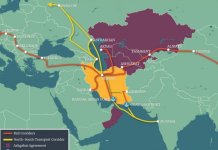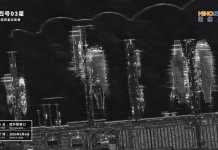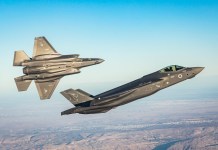How does the Chinese Mother of All Bombs (MOAB) complete gainst Indian SPICE bomb, Russian Father of All Bombs (FOAB) and American Mother of All Bombs (MOAB)? China recently tested its most powerful non-nuclear weapon, dubbed the “Mother of All Bombs” in a reference to a US munition used in Afghanistan. EurAsian Times gets you an insight on the world’s most powerful bombs from the US, Russia, China and India.
Taiwan Views India as “Indispensable Partner” Post Reunification Threat From China
In a short video published on the website of state arms manufacturer Norinco, the massive bomb of China drops on to a plain and produces a gigantic ball of fire and black smoke. The official Xinhua news agency described the bomb for the first time, calling it the “Chinese version of the ‘Mother of all Bombs’”.
The Chinese bomb is five to six metres long (16 to 20 feet), but weighs less than the American version, according to military analyst Wei Dongxu, who was quoted by the semi-official Global Times daily on Friday. “The massive explosion that was generated would easily wipe out land fortifications,” said Wei.
Aviation Thermobaric Bomb of Increased Power: Also known as the ‘Father of All Bombs’ (FOAB), is the Russian answer to the US bomb. Russia, as EurAsian Times reported earlier, successfully tested the weapon in 2007; four years after the US developed the MOAB.
The Russian bomb is reportedly the world’s most powerful non-nuclear bomb, capable of unleashing 44 tons of explosives compared to 11 tons in the GBU-43 MOAB. At 15,650 lb, the FOAB is lighter than the American bomb but the former’s significantly higher blast yield makes it far more lethal.
GBU-43 MOAB: Designed to destroy underground facilities, caves and tunnels, the US developed the GPS-guided bomb for the 2003 invasion of Iraq but it was never used in combat. Just like the Russian bomb, the 30-foot MOAB detonates before hitting the ground and causes unimaginable destruction by sending deadly shockwaves up to a distance of over a mile in all directions. The GBU-43 MOAB, however, is not the heaviest conventional munition in the US arsenal.
GBU-57A/B Massive Ordnance Penetrator: Known by its acronym MOP, the 30,000-lb US bomb is possibly the heaviest conventional weapon in the world. However, the bunker buster bomb’s explosive power doesn’t match that of the MOAB or the FOAB. Manufactured by Boeing, the GBU-57A/B MOP is designed to obliterate underground nuclear facilities and deeply entrenched enemy hideouts.
GBU-28 Hard Target Penetrator: The air forces of Israel and South Korea have the 5,000-lb GBU-28 bunker buster munitions supplied by the US in their inventories. The bombs were deployed by the USAF during Operation Desert Storm to carry out strikes against Iraqi bunkers, military installations and high-value strategic targets in 1991. The GBU-28, a variant of the Paveway III bomb, can reportedly blast through six metres of concrete. The heaviest air-to-surface conventional weapon the fighter can be equipped with is the GBU-24 Paveway II 2,000-lb laser-guided bomb.
SPICE: The Israel-manufactured SPICE (smart precise impact and cost-effective) bomb is the biggest conventional bomb that can be delivered by the Indian Air Force. Manufactured by Israeli firm Rafael Advanced Defence Systems Ltd, the 2000-lb precision-guided bombs are used on the French-origin Mirage 2000 fighters.
The IAF’s Jaguar deep-strike penetration aircraft can be fitted with 1,000-lb bombs for destroying the enemy’s ammunition dumps during combat. In one configuration, a Sukhoi-30 MKI fighter can carry 26 bombs of 550-lb class to destroy a concentration of enemy armour and personnel. The fighter can also carry 1,000-lb HSLD (high speed, low drag) bombs to destroy enemy airfields. Indian fighter planes can also drop indigenously produced 1,000-lb bombs fitted with Israel Aircraft Industries-produced Griffin laser-guided systems.
The EurAsian Times is an English Language Digital News-Site, which specializes in reporting News and Editorials on South Asia, Asia Pacific, Middle East, and the Eurasian Region. EurAsian Times has a strong editorial presence in New Delhi, Dubai, Karachi, and Toronto and have expertise in penning editorials on Defence, Politics, Health, Education and International Relations. A team of highly trained journalists, activists, freelancers and artists contribute to the EurAsian Times, apart from the coverage by its staff writers. The views of the writer may not necessarily reflect the view of EurAsian Times
More News at EurAsian Times
- Indian Military Base in Vietnam To Protect Hanoi’s Territorial Interest
- Indian Military Base in Indonesia can Strangle China at the Strait of Malacca
- Saudi Money, US Weapons, Israeli Intelligence Fuelling Arab NATO – Iran
- Will Ayni Airbase in Tajikistan Become India’s 1st Overseas Military Base?
- Indonesia Opens Another Military Base at Natuna Islands To Counter Aggressive China





